Health Workforce Planning: Australia's Dependence on Migration
VerifiedAdded on 2023/01/16
|13
|2674
|52
Report
AI Summary
This report provides an in-depth analysis of health workforce planning in Australia, focusing on the reliance on international health worker immigration to meet workforce supply and demand. It presents data on the number of clinical health professionals by category who have qualified overseas, offering insights into supply and oversupply issues. The report examines current Australian policies facilitating the migration of international medical staff, evaluating their benefits and challenges. It delves into historical reasons for policy development and assesses the sustainability of the current approach. Finally, the report offers recommendations to the Australian government for creating a more sustainable and beneficial immigration policy for the healthcare system, addressing concerns such as workforce maldistribution, the need for additional training for international health workers, and the potential for health worker shortages in source countries. The study concludes that Australia's immigration policy has played a vital role in improving health care demand in Australia and suggests innovative steps to address the issues to sustain the migration process.
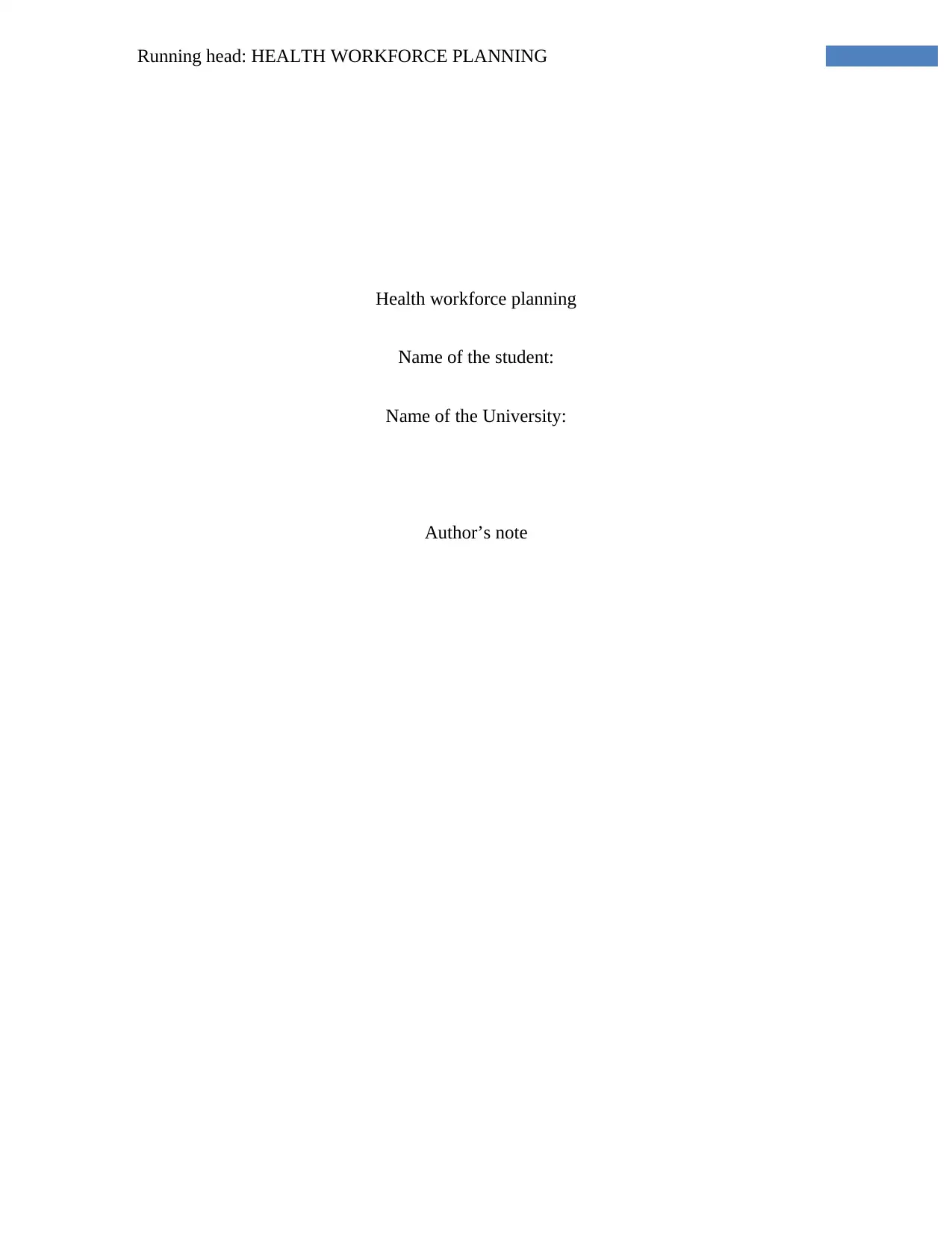
Running head: HEALTH WORKFORCE PLANNING
Health workforce planning
Name of the student:
Name of the University:
Author’s note
Health workforce planning
Name of the student:
Name of the University:
Author’s note
Paraphrase This Document
Need a fresh take? Get an instant paraphrase of this document with our AI Paraphraser
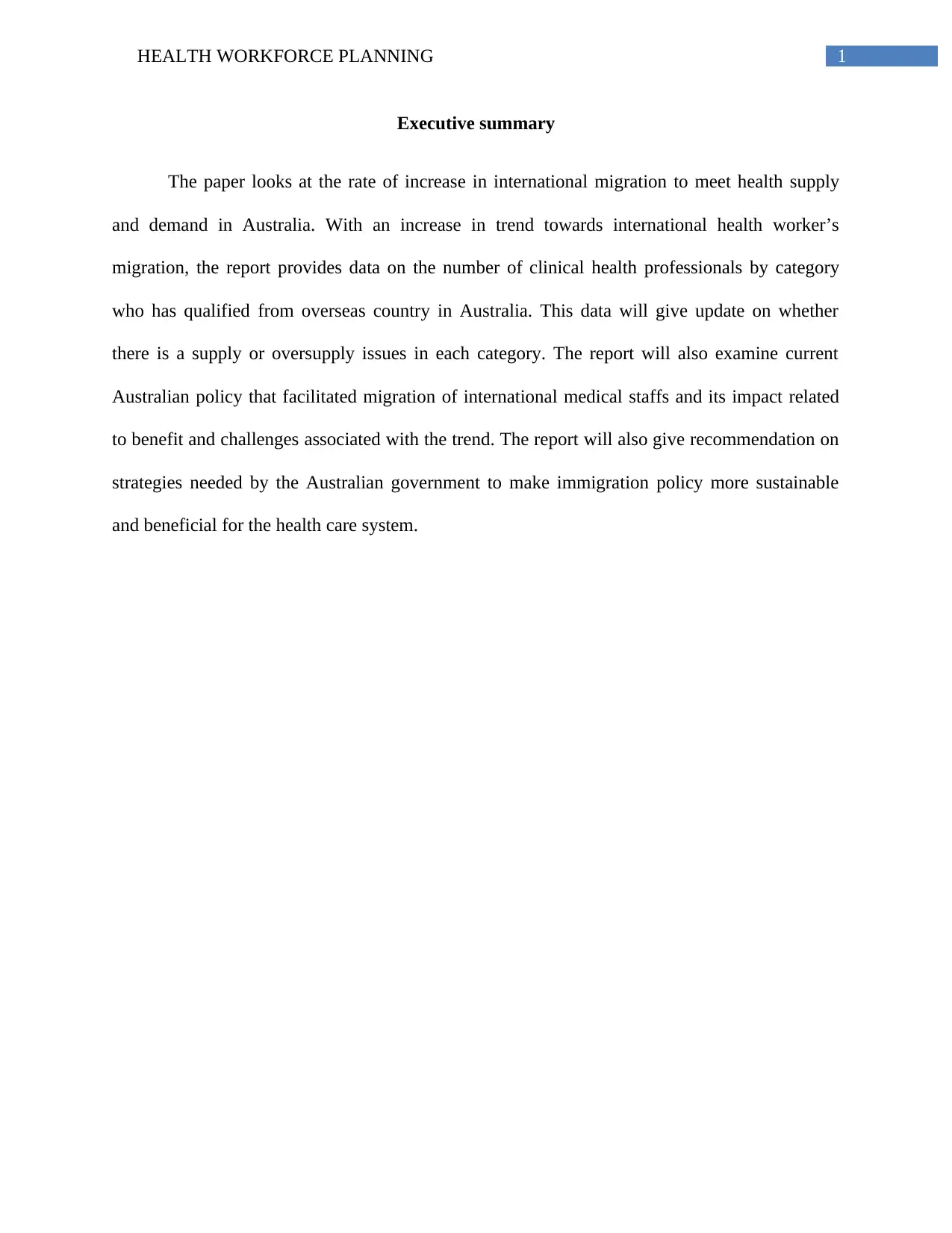
1HEALTH WORKFORCE PLANNING
Executive summary
The paper looks at the rate of increase in international migration to meet health supply
and demand in Australia. With an increase in trend towards international health worker’s
migration, the report provides data on the number of clinical health professionals by category
who has qualified from overseas country in Australia. This data will give update on whether
there is a supply or oversupply issues in each category. The report will also examine current
Australian policy that facilitated migration of international medical staffs and its impact related
to benefit and challenges associated with the trend. The report will also give recommendation on
strategies needed by the Australian government to make immigration policy more sustainable
and beneficial for the health care system.
Executive summary
The paper looks at the rate of increase in international migration to meet health supply
and demand in Australia. With an increase in trend towards international health worker’s
migration, the report provides data on the number of clinical health professionals by category
who has qualified from overseas country in Australia. This data will give update on whether
there is a supply or oversupply issues in each category. The report will also examine current
Australian policy that facilitated migration of international medical staffs and its impact related
to benefit and challenges associated with the trend. The report will also give recommendation on
strategies needed by the Australian government to make immigration policy more sustainable
and beneficial for the health care system.
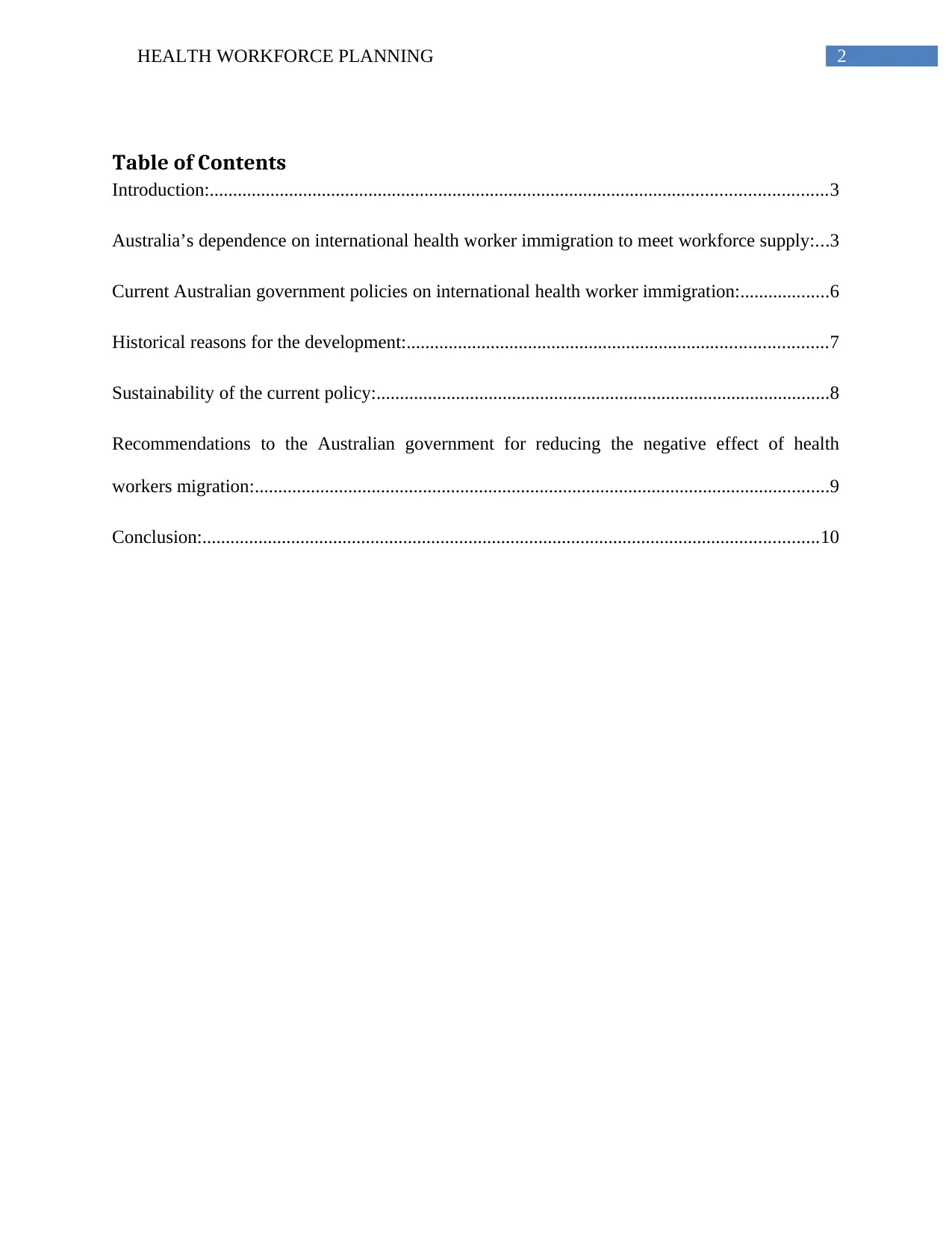
2HEALTH WORKFORCE PLANNING
Table of Contents
Introduction:....................................................................................................................................3
Australia’s dependence on international health worker immigration to meet workforce supply:...3
Current Australian government policies on international health worker immigration:...................6
Historical reasons for the development:..........................................................................................7
Sustainability of the current policy:.................................................................................................8
Recommendations to the Australian government for reducing the negative effect of health
workers migration:...........................................................................................................................9
Conclusion:....................................................................................................................................10
Table of Contents
Introduction:....................................................................................................................................3
Australia’s dependence on international health worker immigration to meet workforce supply:...3
Current Australian government policies on international health worker immigration:...................6
Historical reasons for the development:..........................................................................................7
Sustainability of the current policy:.................................................................................................8
Recommendations to the Australian government for reducing the negative effect of health
workers migration:...........................................................................................................................9
Conclusion:....................................................................................................................................10
⊘ This is a preview!⊘
Do you want full access?
Subscribe today to unlock all pages.

Trusted by 1+ million students worldwide
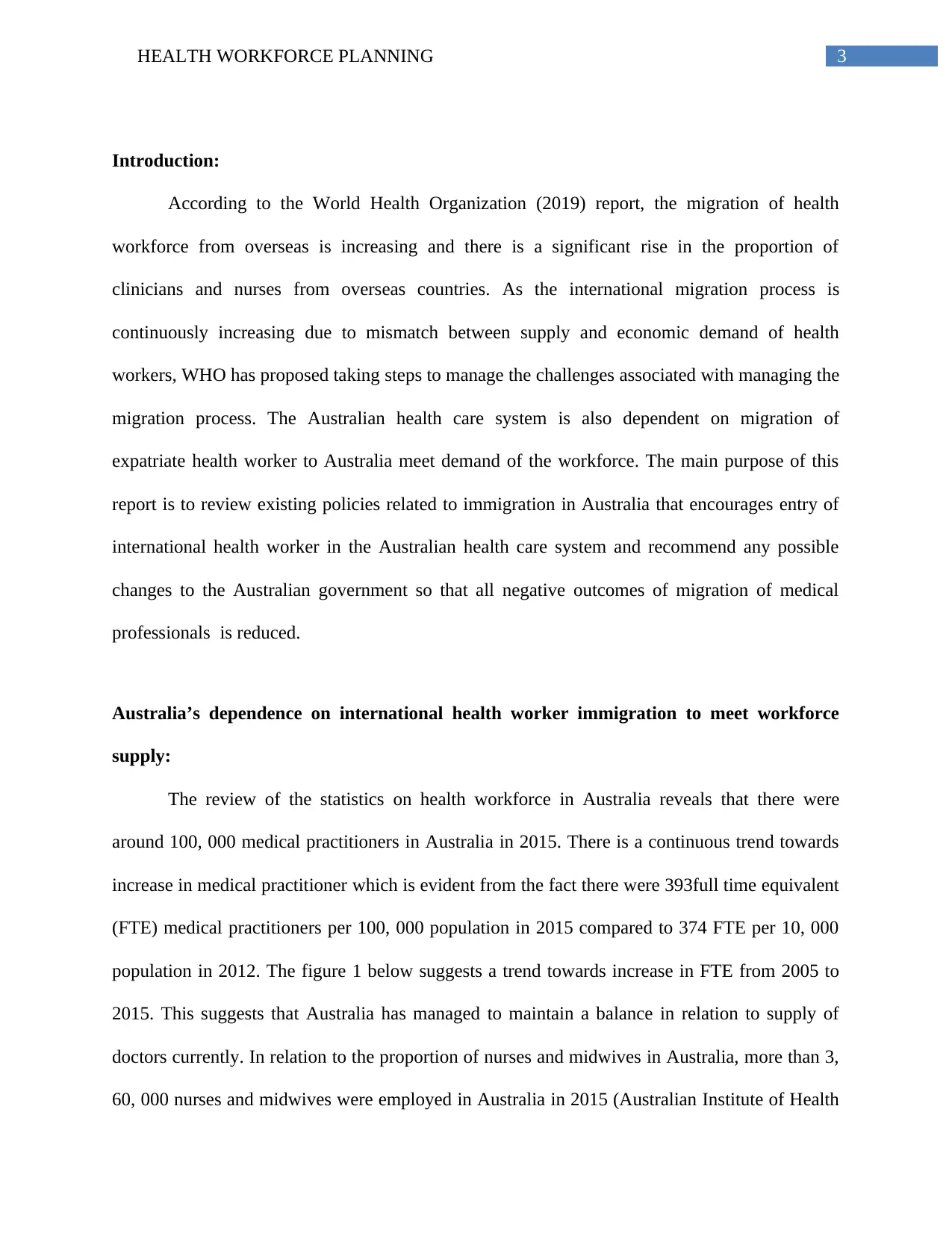
3HEALTH WORKFORCE PLANNING
Introduction:
According to the World Health Organization (2019) report, the migration of health
workforce from overseas is increasing and there is a significant rise in the proportion of
clinicians and nurses from overseas countries. As the international migration process is
continuously increasing due to mismatch between supply and economic demand of health
workers, WHO has proposed taking steps to manage the challenges associated with managing the
migration process. The Australian health care system is also dependent on migration of
expatriate health worker to Australia meet demand of the workforce. The main purpose of this
report is to review existing policies related to immigration in Australia that encourages entry of
international health worker in the Australian health care system and recommend any possible
changes to the Australian government so that all negative outcomes of migration of medical
professionals is reduced.
Australia’s dependence on international health worker immigration to meet workforce
supply:
The review of the statistics on health workforce in Australia reveals that there were
around 100, 000 medical practitioners in Australia in 2015. There is a continuous trend towards
increase in medical practitioner which is evident from the fact there were 393full time equivalent
(FTE) medical practitioners per 100, 000 population in 2015 compared to 374 FTE per 10, 000
population in 2012. The figure 1 below suggests a trend towards increase in FTE from 2005 to
2015. This suggests that Australia has managed to maintain a balance in relation to supply of
doctors currently. In relation to the proportion of nurses and midwives in Australia, more than 3,
60, 000 nurses and midwives were employed in Australia in 2015 (Australian Institute of Health
Introduction:
According to the World Health Organization (2019) report, the migration of health
workforce from overseas is increasing and there is a significant rise in the proportion of
clinicians and nurses from overseas countries. As the international migration process is
continuously increasing due to mismatch between supply and economic demand of health
workers, WHO has proposed taking steps to manage the challenges associated with managing the
migration process. The Australian health care system is also dependent on migration of
expatriate health worker to Australia meet demand of the workforce. The main purpose of this
report is to review existing policies related to immigration in Australia that encourages entry of
international health worker in the Australian health care system and recommend any possible
changes to the Australian government so that all negative outcomes of migration of medical
professionals is reduced.
Australia’s dependence on international health worker immigration to meet workforce
supply:
The review of the statistics on health workforce in Australia reveals that there were
around 100, 000 medical practitioners in Australia in 2015. There is a continuous trend towards
increase in medical practitioner which is evident from the fact there were 393full time equivalent
(FTE) medical practitioners per 100, 000 population in 2015 compared to 374 FTE per 10, 000
population in 2012. The figure 1 below suggests a trend towards increase in FTE from 2005 to
2015. This suggests that Australia has managed to maintain a balance in relation to supply of
doctors currently. In relation to the proportion of nurses and midwives in Australia, more than 3,
60, 000 nurses and midwives were employed in Australia in 2015 (Australian Institute of Health
Paraphrase This Document
Need a fresh take? Get an instant paraphrase of this document with our AI Paraphraser
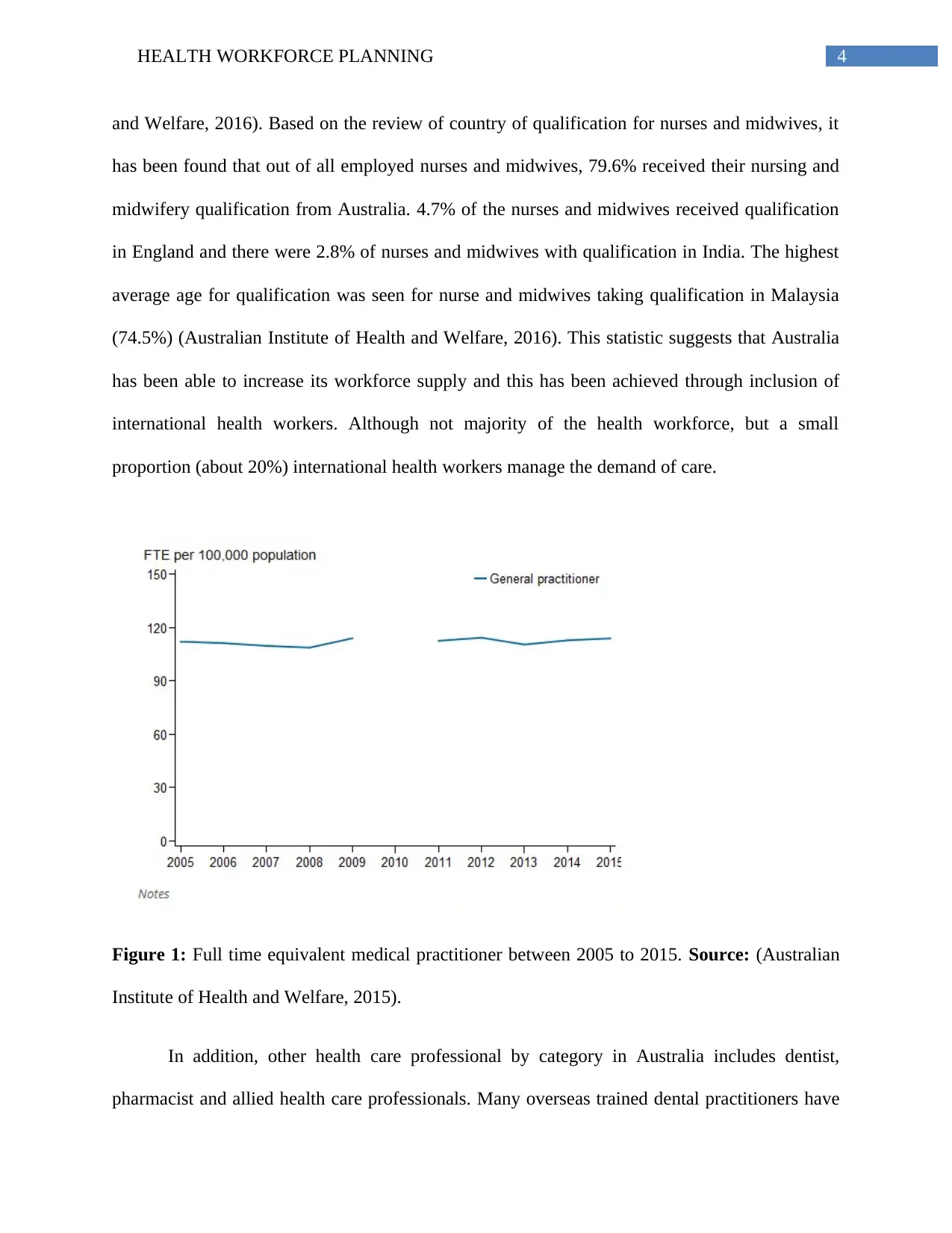
4HEALTH WORKFORCE PLANNING
and Welfare, 2016). Based on the review of country of qualification for nurses and midwives, it
has been found that out of all employed nurses and midwives, 79.6% received their nursing and
midwifery qualification from Australia. 4.7% of the nurses and midwives received qualification
in England and there were 2.8% of nurses and midwives with qualification in India. The highest
average age for qualification was seen for nurse and midwives taking qualification in Malaysia
(74.5%) (Australian Institute of Health and Welfare, 2016). This statistic suggests that Australia
has been able to increase its workforce supply and this has been achieved through inclusion of
international health workers. Although not majority of the health workforce, but a small
proportion (about 20%) international health workers manage the demand of care.
Figure 1: Full time equivalent medical practitioner between 2005 to 2015. Source: (Australian
Institute of Health and Welfare, 2015).
In addition, other health care professional by category in Australia includes dentist,
pharmacist and allied health care professionals. Many overseas trained dental practitioners have
and Welfare, 2016). Based on the review of country of qualification for nurses and midwives, it
has been found that out of all employed nurses and midwives, 79.6% received their nursing and
midwifery qualification from Australia. 4.7% of the nurses and midwives received qualification
in England and there were 2.8% of nurses and midwives with qualification in India. The highest
average age for qualification was seen for nurse and midwives taking qualification in Malaysia
(74.5%) (Australian Institute of Health and Welfare, 2016). This statistic suggests that Australia
has been able to increase its workforce supply and this has been achieved through inclusion of
international health workers. Although not majority of the health workforce, but a small
proportion (about 20%) international health workers manage the demand of care.
Figure 1: Full time equivalent medical practitioner between 2005 to 2015. Source: (Australian
Institute of Health and Welfare, 2015).
In addition, other health care professional by category in Australia includes dentist,
pharmacist and allied health care professionals. Many overseas trained dental practitioners have
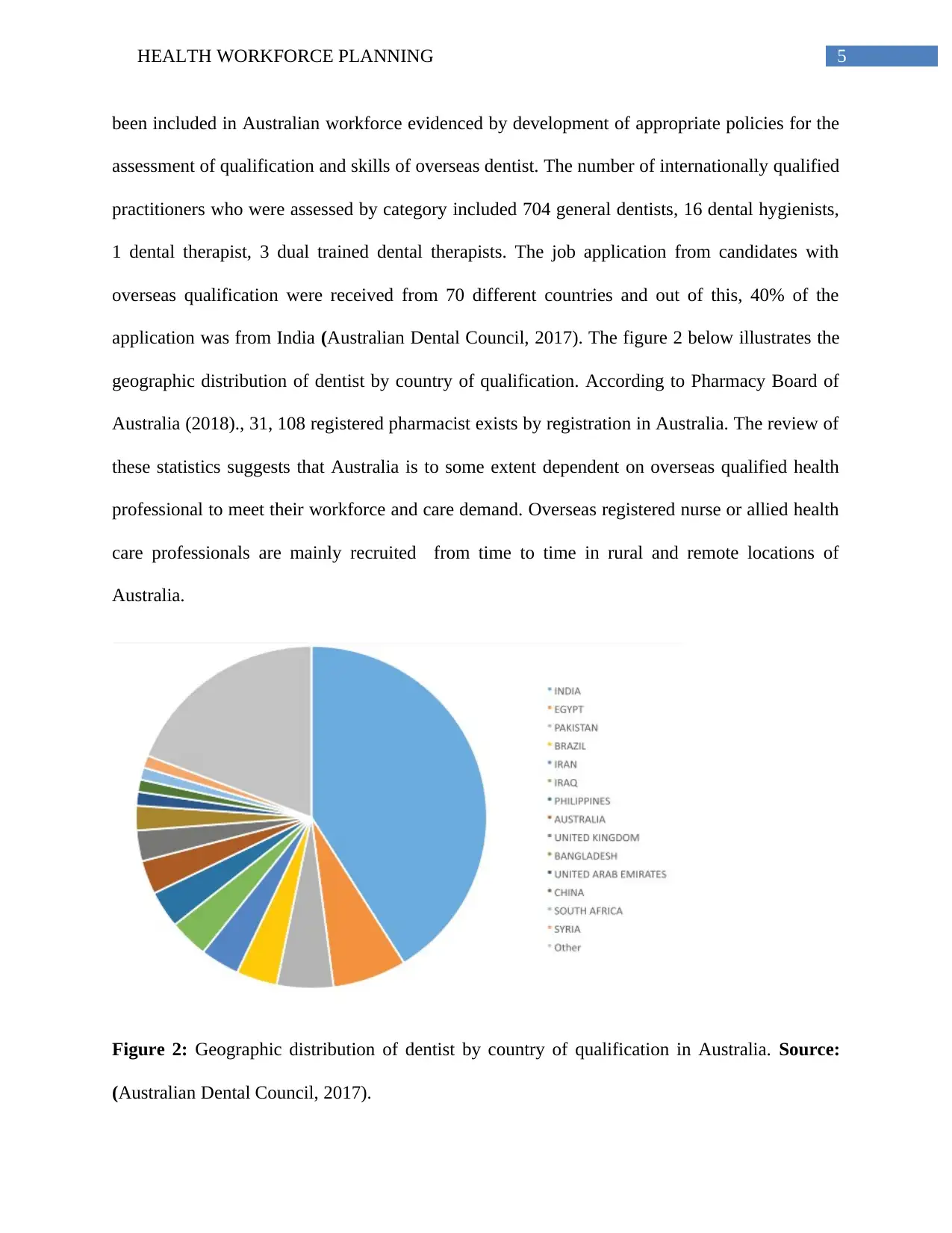
5HEALTH WORKFORCE PLANNING
been included in Australian workforce evidenced by development of appropriate policies for the
assessment of qualification and skills of overseas dentist. The number of internationally qualified
practitioners who were assessed by category included 704 general dentists, 16 dental hygienists,
1 dental therapist, 3 dual trained dental therapists. The job application from candidates with
overseas qualification were received from 70 different countries and out of this, 40% of the
application was from India (Australian Dental Council, 2017). The figure 2 below illustrates the
geographic distribution of dentist by country of qualification. According to Pharmacy Board of
Australia (2018)., 31, 108 registered pharmacist exists by registration in Australia. The review of
these statistics suggests that Australia is to some extent dependent on overseas qualified health
professional to meet their workforce and care demand. Overseas registered nurse or allied health
care professionals are mainly recruited from time to time in rural and remote locations of
Australia.
Figure 2: Geographic distribution of dentist by country of qualification in Australia. Source:
(Australian Dental Council, 2017).
been included in Australian workforce evidenced by development of appropriate policies for the
assessment of qualification and skills of overseas dentist. The number of internationally qualified
practitioners who were assessed by category included 704 general dentists, 16 dental hygienists,
1 dental therapist, 3 dual trained dental therapists. The job application from candidates with
overseas qualification were received from 70 different countries and out of this, 40% of the
application was from India (Australian Dental Council, 2017). The figure 2 below illustrates the
geographic distribution of dentist by country of qualification. According to Pharmacy Board of
Australia (2018)., 31, 108 registered pharmacist exists by registration in Australia. The review of
these statistics suggests that Australia is to some extent dependent on overseas qualified health
professional to meet their workforce and care demand. Overseas registered nurse or allied health
care professionals are mainly recruited from time to time in rural and remote locations of
Australia.
Figure 2: Geographic distribution of dentist by country of qualification in Australia. Source:
(Australian Dental Council, 2017).
⊘ This is a preview!⊘
Do you want full access?
Subscribe today to unlock all pages.

Trusted by 1+ million students worldwide
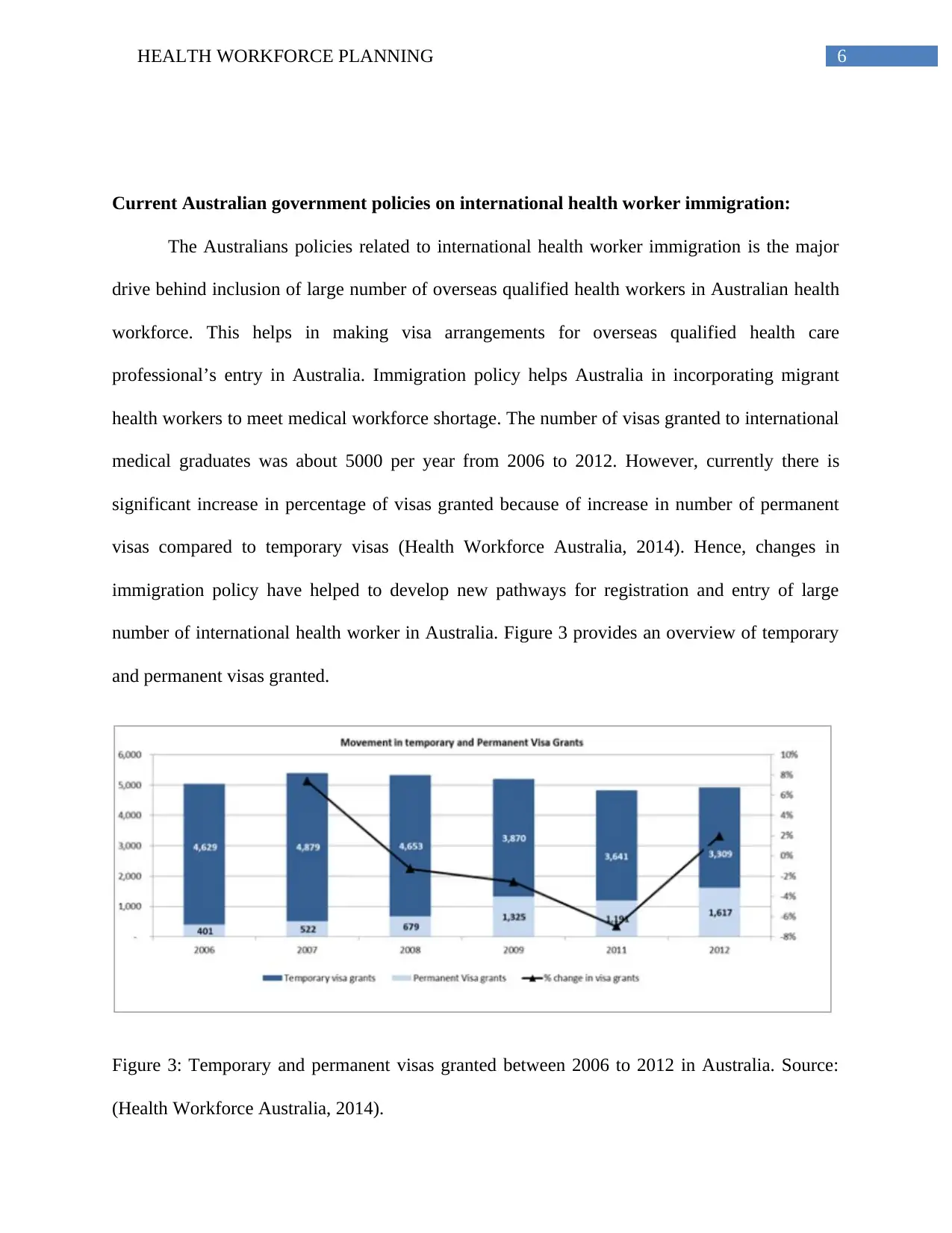
6HEALTH WORKFORCE PLANNING
Current Australian government policies on international health worker immigration:
The Australians policies related to international health worker immigration is the major
drive behind inclusion of large number of overseas qualified health workers in Australian health
workforce. This helps in making visa arrangements for overseas qualified health care
professional’s entry in Australia. Immigration policy helps Australia in incorporating migrant
health workers to meet medical workforce shortage. The number of visas granted to international
medical graduates was about 5000 per year from 2006 to 2012. However, currently there is
significant increase in percentage of visas granted because of increase in number of permanent
visas compared to temporary visas (Health Workforce Australia, 2014). Hence, changes in
immigration policy have helped to develop new pathways for registration and entry of large
number of international health worker in Australia. Figure 3 provides an overview of temporary
and permanent visas granted.
Figure 3: Temporary and permanent visas granted between 2006 to 2012 in Australia. Source:
(Health Workforce Australia, 2014).
Current Australian government policies on international health worker immigration:
The Australians policies related to international health worker immigration is the major
drive behind inclusion of large number of overseas qualified health workers in Australian health
workforce. This helps in making visa arrangements for overseas qualified health care
professional’s entry in Australia. Immigration policy helps Australia in incorporating migrant
health workers to meet medical workforce shortage. The number of visas granted to international
medical graduates was about 5000 per year from 2006 to 2012. However, currently there is
significant increase in percentage of visas granted because of increase in number of permanent
visas compared to temporary visas (Health Workforce Australia, 2014). Hence, changes in
immigration policy have helped to develop new pathways for registration and entry of large
number of international health worker in Australia. Figure 3 provides an overview of temporary
and permanent visas granted.
Figure 3: Temporary and permanent visas granted between 2006 to 2012 in Australia. Source:
(Health Workforce Australia, 2014).
Paraphrase This Document
Need a fresh take? Get an instant paraphrase of this document with our AI Paraphraser
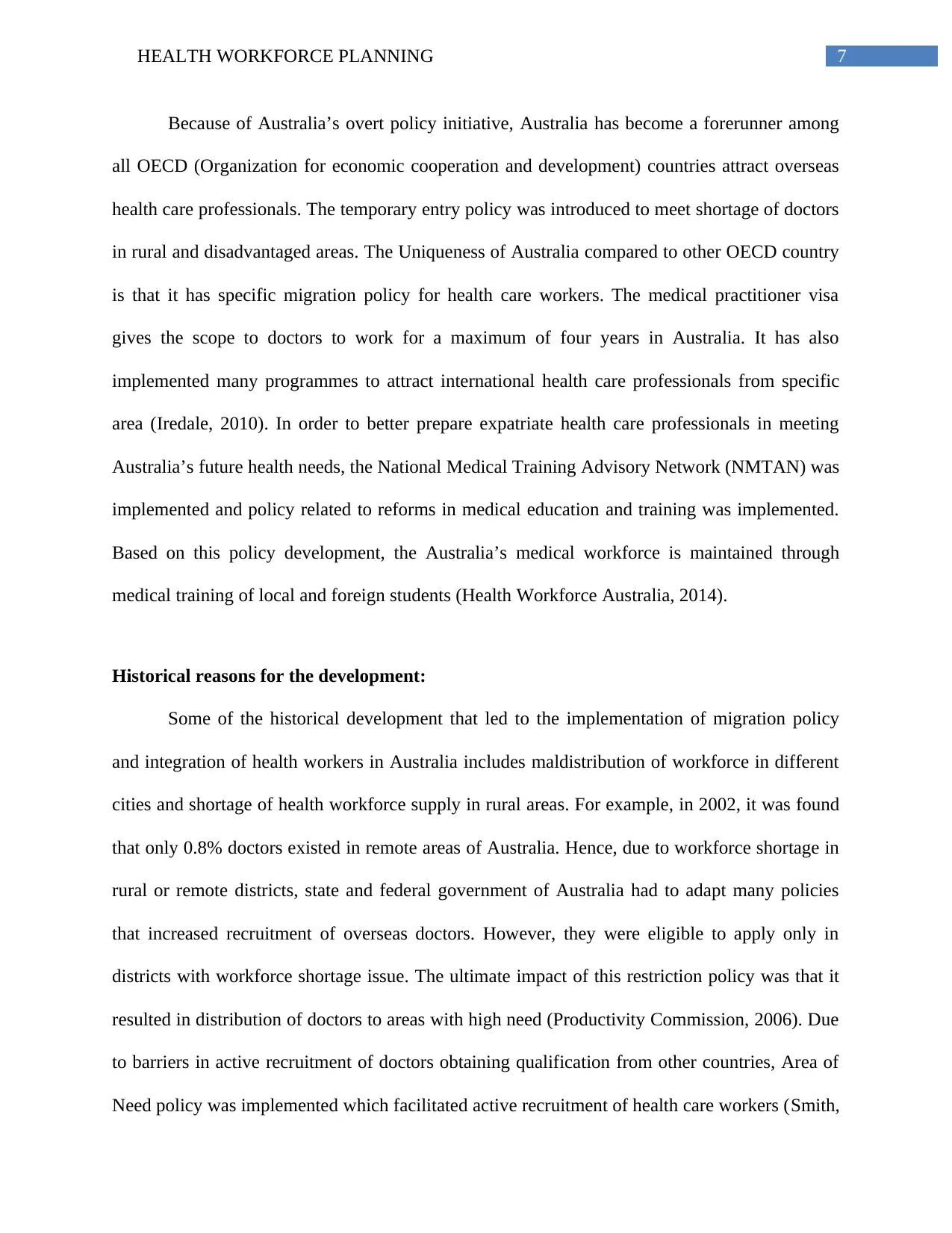
7HEALTH WORKFORCE PLANNING
Because of Australia’s overt policy initiative, Australia has become a forerunner among
all OECD (Organization for economic cooperation and development) countries attract overseas
health care professionals. The temporary entry policy was introduced to meet shortage of doctors
in rural and disadvantaged areas. The Uniqueness of Australia compared to other OECD country
is that it has specific migration policy for health care workers. The medical practitioner visa
gives the scope to doctors to work for a maximum of four years in Australia. It has also
implemented many programmes to attract international health care professionals from specific
area (Iredale, 2010). In order to better prepare expatriate health care professionals in meeting
Australia’s future health needs, the National Medical Training Advisory Network (NMTAN) was
implemented and policy related to reforms in medical education and training was implemented.
Based on this policy development, the Australia’s medical workforce is maintained through
medical training of local and foreign students (Health Workforce Australia, 2014).
Historical reasons for the development:
Some of the historical development that led to the implementation of migration policy
and integration of health workers in Australia includes maldistribution of workforce in different
cities and shortage of health workforce supply in rural areas. For example, in 2002, it was found
that only 0.8% doctors existed in remote areas of Australia. Hence, due to workforce shortage in
rural or remote districts, state and federal government of Australia had to adapt many policies
that increased recruitment of overseas doctors. However, they were eligible to apply only in
districts with workforce shortage issue. The ultimate impact of this restriction policy was that it
resulted in distribution of doctors to areas with high need (Productivity Commission, 2006). Due
to barriers in active recruitment of doctors obtaining qualification from other countries, Area of
Need policy was implemented which facilitated active recruitment of health care workers (Smith,
Because of Australia’s overt policy initiative, Australia has become a forerunner among
all OECD (Organization for economic cooperation and development) countries attract overseas
health care professionals. The temporary entry policy was introduced to meet shortage of doctors
in rural and disadvantaged areas. The Uniqueness of Australia compared to other OECD country
is that it has specific migration policy for health care workers. The medical practitioner visa
gives the scope to doctors to work for a maximum of four years in Australia. It has also
implemented many programmes to attract international health care professionals from specific
area (Iredale, 2010). In order to better prepare expatriate health care professionals in meeting
Australia’s future health needs, the National Medical Training Advisory Network (NMTAN) was
implemented and policy related to reforms in medical education and training was implemented.
Based on this policy development, the Australia’s medical workforce is maintained through
medical training of local and foreign students (Health Workforce Australia, 2014).
Historical reasons for the development:
Some of the historical development that led to the implementation of migration policy
and integration of health workers in Australia includes maldistribution of workforce in different
cities and shortage of health workforce supply in rural areas. For example, in 2002, it was found
that only 0.8% doctors existed in remote areas of Australia. Hence, due to workforce shortage in
rural or remote districts, state and federal government of Australia had to adapt many policies
that increased recruitment of overseas doctors. However, they were eligible to apply only in
districts with workforce shortage issue. The ultimate impact of this restriction policy was that it
resulted in distribution of doctors to areas with high need (Productivity Commission, 2006). Due
to barriers in active recruitment of doctors obtaining qualification from other countries, Area of
Need policy was implemented which facilitated active recruitment of health care workers (Smith,
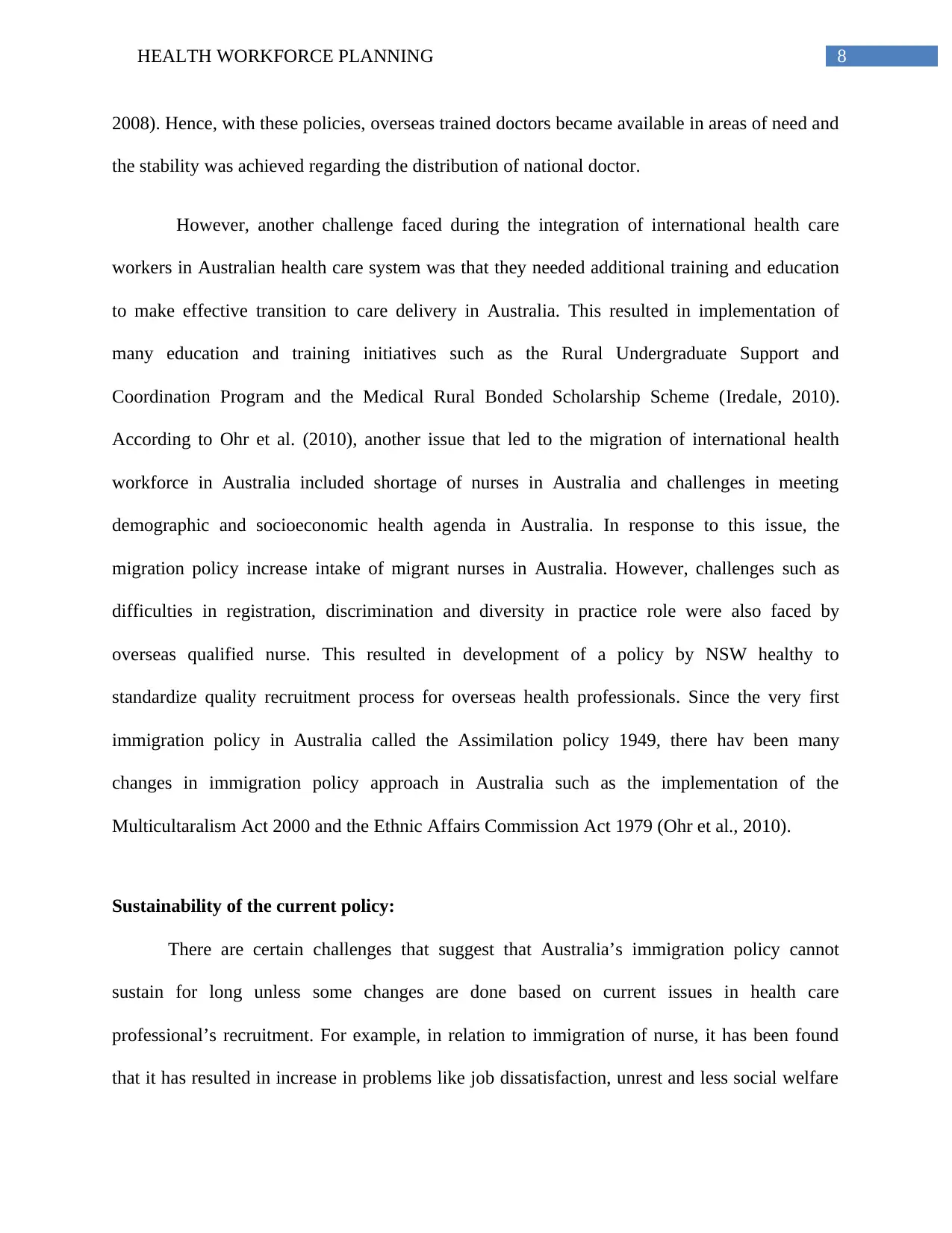
8HEALTH WORKFORCE PLANNING
2008). Hence, with these policies, overseas trained doctors became available in areas of need and
the stability was achieved regarding the distribution of national doctor.
However, another challenge faced during the integration of international health care
workers in Australian health care system was that they needed additional training and education
to make effective transition to care delivery in Australia. This resulted in implementation of
many education and training initiatives such as the Rural Undergraduate Support and
Coordination Program and the Medical Rural Bonded Scholarship Scheme (Iredale, 2010).
According to Ohr et al. (2010), another issue that led to the migration of international health
workforce in Australia included shortage of nurses in Australia and challenges in meeting
demographic and socioeconomic health agenda in Australia. In response to this issue, the
migration policy increase intake of migrant nurses in Australia. However, challenges such as
difficulties in registration, discrimination and diversity in practice role were also faced by
overseas qualified nurse. This resulted in development of a policy by NSW healthy to
standardize quality recruitment process for overseas health professionals. Since the very first
immigration policy in Australia called the Assimilation policy 1949, there hav been many
changes in immigration policy approach in Australia such as the implementation of the
Multicultaralism Act 2000 and the Ethnic Affairs Commission Act 1979 (Ohr et al., 2010).
Sustainability of the current policy:
There are certain challenges that suggest that Australia’s immigration policy cannot
sustain for long unless some changes are done based on current issues in health care
professional’s recruitment. For example, in relation to immigration of nurse, it has been found
that it has resulted in increase in problems like job dissatisfaction, unrest and less social welfare
2008). Hence, with these policies, overseas trained doctors became available in areas of need and
the stability was achieved regarding the distribution of national doctor.
However, another challenge faced during the integration of international health care
workers in Australian health care system was that they needed additional training and education
to make effective transition to care delivery in Australia. This resulted in implementation of
many education and training initiatives such as the Rural Undergraduate Support and
Coordination Program and the Medical Rural Bonded Scholarship Scheme (Iredale, 2010).
According to Ohr et al. (2010), another issue that led to the migration of international health
workforce in Australia included shortage of nurses in Australia and challenges in meeting
demographic and socioeconomic health agenda in Australia. In response to this issue, the
migration policy increase intake of migrant nurses in Australia. However, challenges such as
difficulties in registration, discrimination and diversity in practice role were also faced by
overseas qualified nurse. This resulted in development of a policy by NSW healthy to
standardize quality recruitment process for overseas health professionals. Since the very first
immigration policy in Australia called the Assimilation policy 1949, there hav been many
changes in immigration policy approach in Australia such as the implementation of the
Multicultaralism Act 2000 and the Ethnic Affairs Commission Act 1979 (Ohr et al., 2010).
Sustainability of the current policy:
There are certain challenges that suggest that Australia’s immigration policy cannot
sustain for long unless some changes are done based on current issues in health care
professional’s recruitment. For example, in relation to immigration of nurse, it has been found
that it has resulted in increase in problems like job dissatisfaction, unrest and less social welfare
⊘ This is a preview!⊘
Do you want full access?
Subscribe today to unlock all pages.

Trusted by 1+ million students worldwide
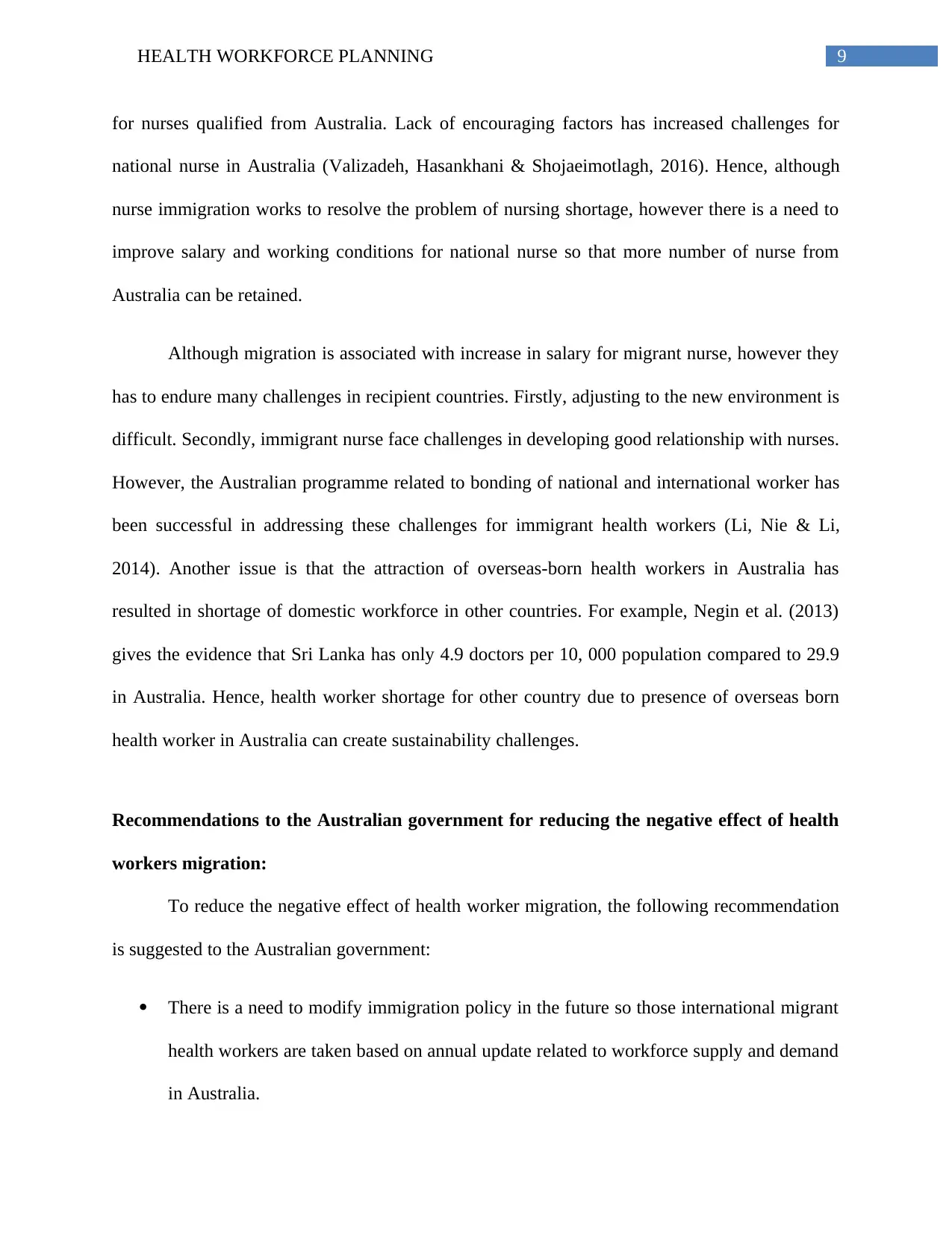
9HEALTH WORKFORCE PLANNING
for nurses qualified from Australia. Lack of encouraging factors has increased challenges for
national nurse in Australia (Valizadeh, Hasankhani & Shojaeimotlagh, 2016). Hence, although
nurse immigration works to resolve the problem of nursing shortage, however there is a need to
improve salary and working conditions for national nurse so that more number of nurse from
Australia can be retained.
Although migration is associated with increase in salary for migrant nurse, however they
has to endure many challenges in recipient countries. Firstly, adjusting to the new environment is
difficult. Secondly, immigrant nurse face challenges in developing good relationship with nurses.
However, the Australian programme related to bonding of national and international worker has
been successful in addressing these challenges for immigrant health workers (Li, Nie & Li,
2014). Another issue is that the attraction of overseas-born health workers in Australia has
resulted in shortage of domestic workforce in other countries. For example, Negin et al. (2013)
gives the evidence that Sri Lanka has only 4.9 doctors per 10, 000 population compared to 29.9
in Australia. Hence, health worker shortage for other country due to presence of overseas born
health worker in Australia can create sustainability challenges.
Recommendations to the Australian government for reducing the negative effect of health
workers migration:
To reduce the negative effect of health worker migration, the following recommendation
is suggested to the Australian government:
There is a need to modify immigration policy in the future so those international migrant
health workers are taken based on annual update related to workforce supply and demand
in Australia.
for nurses qualified from Australia. Lack of encouraging factors has increased challenges for
national nurse in Australia (Valizadeh, Hasankhani & Shojaeimotlagh, 2016). Hence, although
nurse immigration works to resolve the problem of nursing shortage, however there is a need to
improve salary and working conditions for national nurse so that more number of nurse from
Australia can be retained.
Although migration is associated with increase in salary for migrant nurse, however they
has to endure many challenges in recipient countries. Firstly, adjusting to the new environment is
difficult. Secondly, immigrant nurse face challenges in developing good relationship with nurses.
However, the Australian programme related to bonding of national and international worker has
been successful in addressing these challenges for immigrant health workers (Li, Nie & Li,
2014). Another issue is that the attraction of overseas-born health workers in Australia has
resulted in shortage of domestic workforce in other countries. For example, Negin et al. (2013)
gives the evidence that Sri Lanka has only 4.9 doctors per 10, 000 population compared to 29.9
in Australia. Hence, health worker shortage for other country due to presence of overseas born
health worker in Australia can create sustainability challenges.
Recommendations to the Australian government for reducing the negative effect of health
workers migration:
To reduce the negative effect of health worker migration, the following recommendation
is suggested to the Australian government:
There is a need to modify immigration policy in the future so those international migrant
health workers are taken based on annual update related to workforce supply and demand
in Australia.
Paraphrase This Document
Need a fresh take? Get an instant paraphrase of this document with our AI Paraphraser
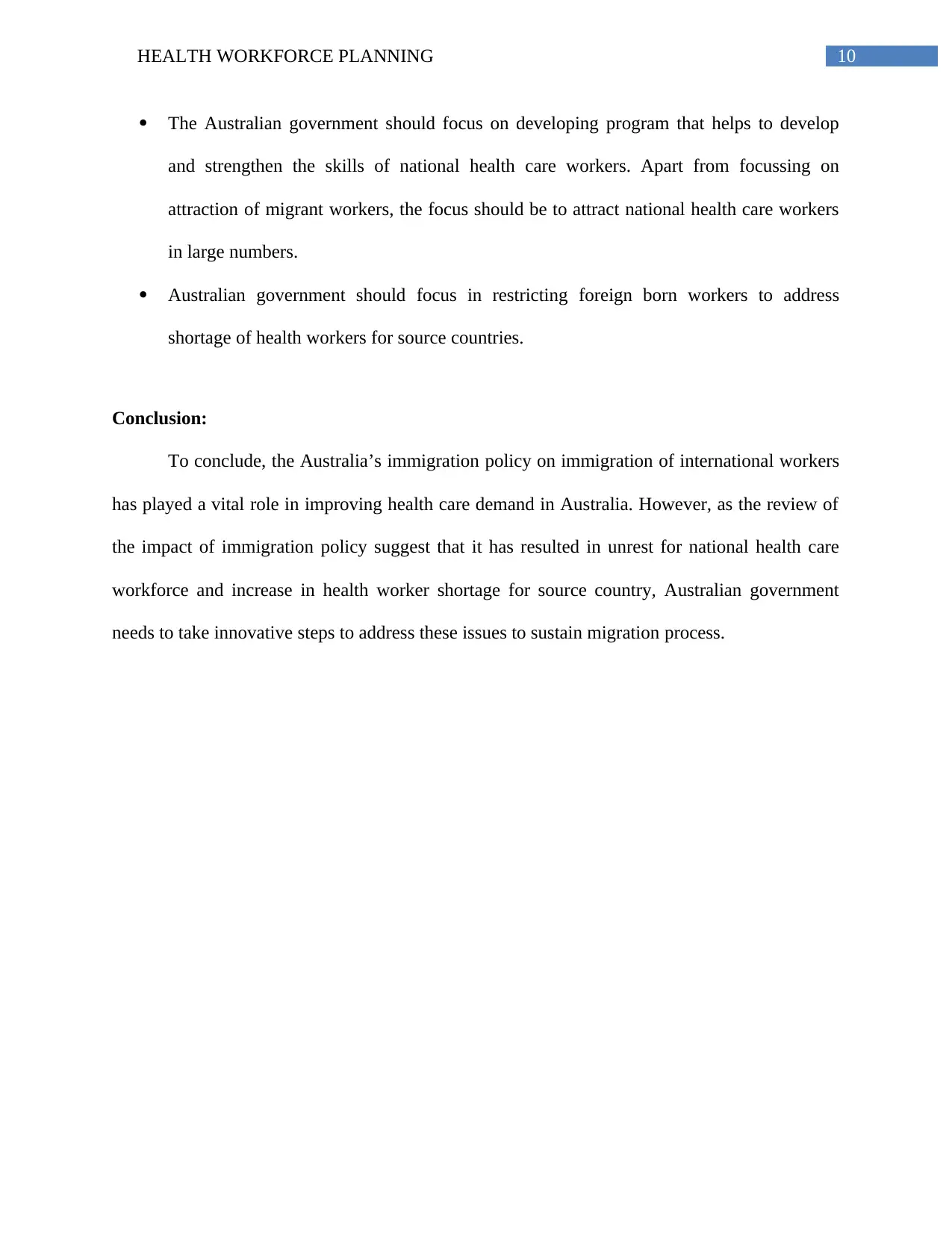
10HEALTH WORKFORCE PLANNING
The Australian government should focus on developing program that helps to develop
and strengthen the skills of national health care workers. Apart from focussing on
attraction of migrant workers, the focus should be to attract national health care workers
in large numbers.
Australian government should focus in restricting foreign born workers to address
shortage of health workers for source countries.
Conclusion:
To conclude, the Australia’s immigration policy on immigration of international workers
has played a vital role in improving health care demand in Australia. However, as the review of
the impact of immigration policy suggest that it has resulted in unrest for national health care
workforce and increase in health worker shortage for source country, Australian government
needs to take innovative steps to address these issues to sustain migration process.
The Australian government should focus on developing program that helps to develop
and strengthen the skills of national health care workers. Apart from focussing on
attraction of migrant workers, the focus should be to attract national health care workers
in large numbers.
Australian government should focus in restricting foreign born workers to address
shortage of health workers for source countries.
Conclusion:
To conclude, the Australia’s immigration policy on immigration of international workers
has played a vital role in improving health care demand in Australia. However, as the review of
the impact of immigration policy suggest that it has resulted in unrest for national health care
workforce and increase in health worker shortage for source country, Australian government
needs to take innovative steps to address these issues to sustain migration process.
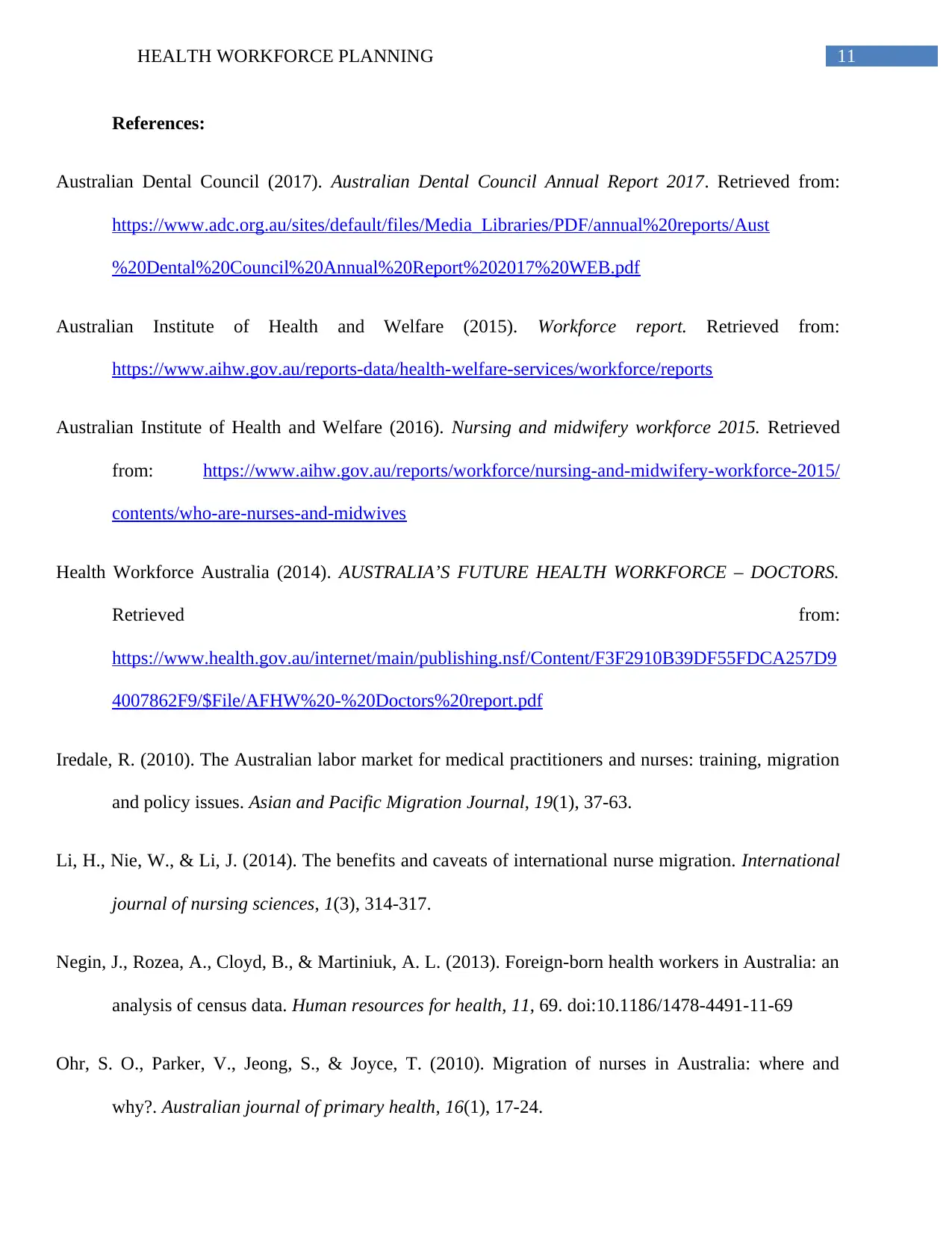
11HEALTH WORKFORCE PLANNING
References:
Australian Dental Council (2017). Australian Dental Council Annual Report 2017. Retrieved from:
https://www.adc.org.au/sites/default/files/Media_Libraries/PDF/annual%20reports/Aust
%20Dental%20Council%20Annual%20Report%202017%20WEB.pdf
Australian Institute of Health and Welfare (2015). Workforce report. Retrieved from:
https://www.aihw.gov.au/reports-data/health-welfare-services/workforce/reports
Australian Institute of Health and Welfare (2016). Nursing and midwifery workforce 2015. Retrieved
from: https://www.aihw.gov.au/reports/workforce/nursing-and-midwifery-workforce-2015/
contents/who-are-nurses-and-midwives
Health Workforce Australia (2014). AUSTRALIA’S FUTURE HEALTH WORKFORCE – DOCTORS.
Retrieved from:
https://www.health.gov.au/internet/main/publishing.nsf/Content/F3F2910B39DF55FDCA257D9
4007862F9/$File/AFHW%20-%20Doctors%20report.pdf
Iredale, R. (2010). The Australian labor market for medical practitioners and nurses: training, migration
and policy issues. Asian and Pacific Migration Journal, 19(1), 37-63.
Li, H., Nie, W., & Li, J. (2014). The benefits and caveats of international nurse migration. International
journal of nursing sciences, 1(3), 314-317.
Negin, J., Rozea, A., Cloyd, B., & Martiniuk, A. L. (2013). Foreign-born health workers in Australia: an
analysis of census data. Human resources for health, 11, 69. doi:10.1186/1478-4491-11-69
Ohr, S. O., Parker, V., Jeong, S., & Joyce, T. (2010). Migration of nurses in Australia: where and
why?. Australian journal of primary health, 16(1), 17-24.
References:
Australian Dental Council (2017). Australian Dental Council Annual Report 2017. Retrieved from:
https://www.adc.org.au/sites/default/files/Media_Libraries/PDF/annual%20reports/Aust
%20Dental%20Council%20Annual%20Report%202017%20WEB.pdf
Australian Institute of Health and Welfare (2015). Workforce report. Retrieved from:
https://www.aihw.gov.au/reports-data/health-welfare-services/workforce/reports
Australian Institute of Health and Welfare (2016). Nursing and midwifery workforce 2015. Retrieved
from: https://www.aihw.gov.au/reports/workforce/nursing-and-midwifery-workforce-2015/
contents/who-are-nurses-and-midwives
Health Workforce Australia (2014). AUSTRALIA’S FUTURE HEALTH WORKFORCE – DOCTORS.
Retrieved from:
https://www.health.gov.au/internet/main/publishing.nsf/Content/F3F2910B39DF55FDCA257D9
4007862F9/$File/AFHW%20-%20Doctors%20report.pdf
Iredale, R. (2010). The Australian labor market for medical practitioners and nurses: training, migration
and policy issues. Asian and Pacific Migration Journal, 19(1), 37-63.
Li, H., Nie, W., & Li, J. (2014). The benefits and caveats of international nurse migration. International
journal of nursing sciences, 1(3), 314-317.
Negin, J., Rozea, A., Cloyd, B., & Martiniuk, A. L. (2013). Foreign-born health workers in Australia: an
analysis of census data. Human resources for health, 11, 69. doi:10.1186/1478-4491-11-69
Ohr, S. O., Parker, V., Jeong, S., & Joyce, T. (2010). Migration of nurses in Australia: where and
why?. Australian journal of primary health, 16(1), 17-24.
⊘ This is a preview!⊘
Do you want full access?
Subscribe today to unlock all pages.

Trusted by 1+ million students worldwide
1 out of 13
Related Documents
Your All-in-One AI-Powered Toolkit for Academic Success.
+13062052269
info@desklib.com
Available 24*7 on WhatsApp / Email
![[object Object]](/_next/static/media/star-bottom.7253800d.svg)
Unlock your academic potential
Copyright © 2020–2025 A2Z Services. All Rights Reserved. Developed and managed by ZUCOL.





